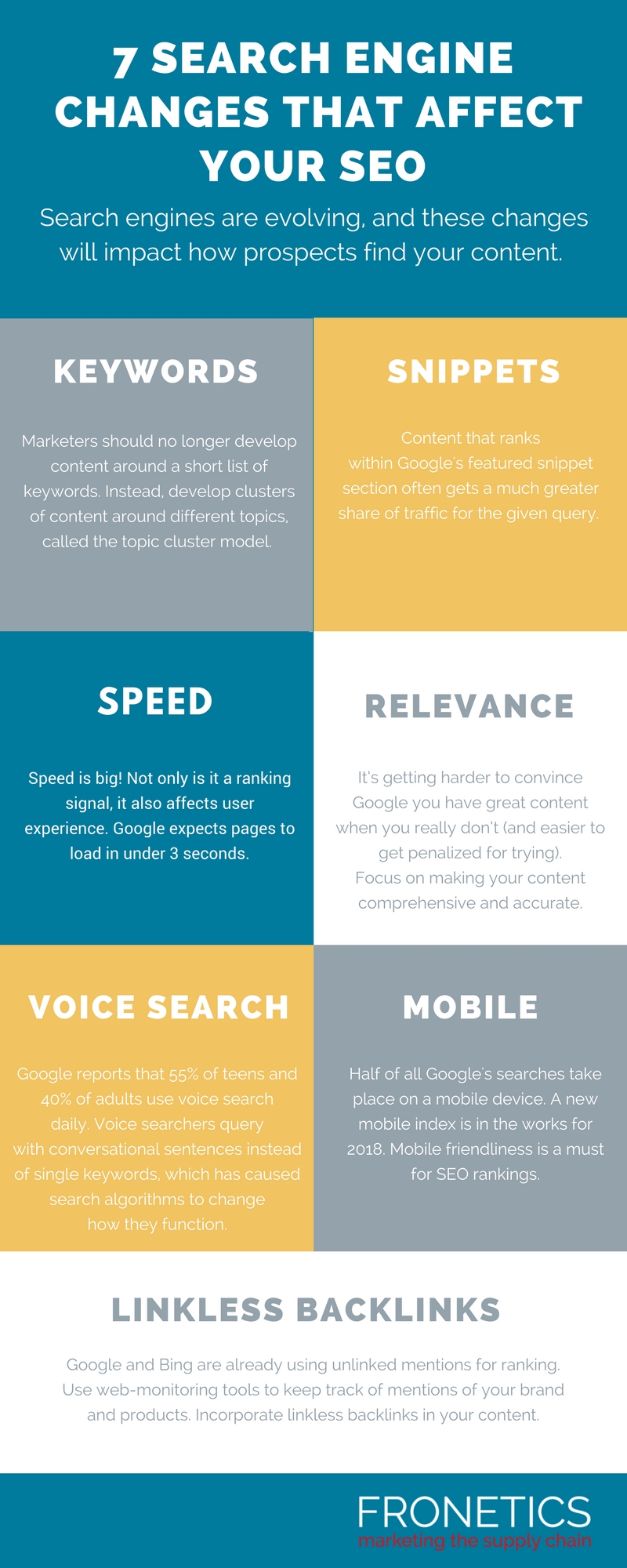
by Fronetics | Feb 19, 2018 | Blog, Content Marketing, Logistics, Marketing, Supply Chain
Search engines are evolving, and these changes will have big impacts on how searchers find your content. Here are 7 changes that will affect your SEO.
Internet users are changing how they search, and in response, search engines are changing how they rank content. Newer, more sophisticated algorithms have had big impacts on SEO rankings and the changes haven’t stopped there. Search engines are working around the clock to improve how content ranks for their users. Google and Bing want to ensure its readers are getting the quality content they deserve.
What does this mean for your SEO? It can be very challenging to understand all of the factors that go into a search engine’s algorithm for rankings. Google has over 205 factors that play a part in determining where you content lands in a search and they’re always changing. Instead of worrying about all of those components, here are 7 changes that have big impacts and are easy to integrate into your content.
7 search engine changes you need to know: infographic

Changes to the way search engines work do present a challenge for content creators writing for SEO. But keeping pace with the ever-changing technology is key to keeping your content relevant. Keeping these 7 key changes in mind, content writers can work to integrate these changes into their new content, as well as update older content.
Ultimately, the best way to improve your SEO is through your content. Quality content that is valuable to your target audience should be your biggest priority. With good content and keeping these 7 changes at the forefront, you will be able to optimize your posts and increase the likelihood internet searchers will find them.
Related posts:


by Fronetics | Feb 5, 2018 | Blog, Content Marketing, Marketing
Internet users are changing how they search, and search engines are changing in response — which means writing for SEO is changing, too. Here’s what you need to know.
I’ve just completed a really detailed, often-complicated series about writing for SEO in today’s changing search landscape. I hope you read all four posts and now have a better understanding of the new way we marketers are thinking about content marketing.
But, as my colleagues occasionally have to remind me, not everyone enjoys the nitty gritty of SEO writing like I do. It’s also important to step back and take a look at the forest after examining the trees.
So here are some really important takeaways from the series — about how internet users, search engines, and writing for SEO are changing — that I think are important for all marketers in the supply chain and logistics industries.
4 things to know in a changing search landscape
1) Search engines are changing.
While keyword rankings used to be the gold standard for measuring SEO success, this is no longer the case. New search algorithms have moved beyond giving everyone the same results of a query, meaning that keyword ranking can change drastically depending on context (like location).
In addition, Google is increasingly showing featured snippets at the top of search results.
What you need to do:
Know that measuring SEO success is no longer as simple as keeping track of keyword rankings. It’s still information worth having, but it’s part of a larger set of metrics you need to evaluate your success and tailor your efforts.
To effectively take advantage of featured snippets, it’s important to structure your content so it’s optimized to appear in this prime location.
Read the full post.
2) People are changing how they search.
Because of the rise of mobile and voice search, people are now searching with a phrase or question rather than a single term. In response, search engine development has focused on natural language processing — meaning search engines now analyze phrases as a whole rather than a keyword. That essentially means they evaluate a site’s content regarding an entire topic rather than its use of a particular word in order to deliver the best answers to users’ queries. Basically, we’re looking at the same issue as the last post, but from the user end.
What you need to do:
Stop trying to rank for a small set of keywords. What’s important is broad visibility across a topic. You should start thinking about the major themes of your content and then build posts and website pages to support them.
Read the full post.
3) Structure your content in topic clusters and pillar content.
Pillar content is your evergreen content that offer a high-level overview of the several ideas/phrases/value propositions that most closely align with your brand. Topic clusters are the subtopics that provide more detail on those high-level ideas of your pillar content. Adding hyperlinks to pillar content pages from topic cluster pages and vice versa creates a structure that signals to search engines that your site has lots of good, well-organized information about a certain topic, which improves ranking across that topic.
What you need to do:
Structure your content into pillar content and topic clusters. Add hyperlinks between the pages. Optimize topic cluster pages to drive traffic and pillar content pages to convert leads.
Read the full post.
4) Measure the success of your content.
Measuring success is getting more complex. You can no longer effectively gauge the effectiveness of campaigns on a post-by-post basis. Instead, measure your visibility across each topic.
What you need to do:
Start looking at the bigger picture. Consider how all content under each cluster topic performs as a whole. As you do this, keep the big four questions in mind:
1) Which topics perform best at driving traffic to your website or other web presence?
2) Which topics earn you the most leads?
3) Which topics drive the most revenue to your business?
4) Which topics earn the most backlinks/coverage?
Read the full post.
Related posts:


by Fronetics | Oct 16, 2017 | Blog, Leadership, Talent
Google trains new managers in these six areas to make them highly effective leaders.
When you think of the word “manager,” you associate it with leadership. (Or, at least, I do.) But the two don’t necessarily go hand in hand.
Being a manager is just a position; a leader is something more. Oftentimes the skills that get people promoted to the managerial level don’t necessarily make them effective leaders. Then you’re stuck with managers that can’t lead, and that’s a problem. (See How to Be a Bad Leader: 6 Common Characteristics of Poor Leadership.)
Lucky for us, organizations like Google have spent years researching what makes an effective manager. Using Project Oxygen, an internal study analyzing more than 10,000 manager impressions, Google identified 8 habits of highly effective managers, which the company now uses to train new managers. Google shares this presentation through the re:Work website, which focuses on 6 key attributes.
6 key attributes of highly effective managers
1. Mindset and values
Dr. Carol Dweck, a professor of psychology at Stanford University, studied the science of growth mindset, the belief that intelligence can be cultivated. Project Oxygen showed that productive leaders live this philosophy at work. They are eager to learn, take risks, and challenge themselves — all of which ultimately boost their performance.
Also, Google empowers new managers to leverage their individual values in their management styles. This drives deeper meaning into their work and supports them when they, inevitably, need to make tough decisions.
2. Emotional intelligence
Emotional intelligence is the ability to recognize emotions in yourself and others, and leverage this awareness to manage behavior and relationships. Managers who are emotionally intelligent make better decisions, communicate more effectively, and seem more relatable to employees. They can better control the emotional climate of the workplace by anticipating employees’ needs and creating an environment that supports them.
3. Manager transition
Google has new managers share the challenges, surprises, and frustrations of their transition from individual contributor to supervisor. This not only teaches that it’s ok to be vulnerable and honest, but also encourages others to offer advice and to help devise actionable new strategies.
4. Coaching
A good coach nurtures and grows the talent on his/her team. The positive effects impact more than just team performance. Research by the Human Capital Institute and the International Coaching Federation shows that a strong coaching culture increases employee engagement and revenue growth.
Google defines good coaching as:
- Timely and specific feedback
- Delivering hard feedback in a motivational and thoughtful way
- Tailoring approaches to meet individual communication styles in regular one-on-one meetings
- Practicing empathetic “active” listening and being fully present
- Being cognizant of your own mindset and that of the employee
- Asking open-ended questions to discover an employee’s acumen
5. Feedback
“Embrace bad news to learn where you need the most improvement.” — Bill Gates
The purpose of feedback is to improve performance and foster professional growth. But words can hurt, and employees can interpret constructive criticism as an attack. Thus, the ability to provide feedback effectively is essential for any manager.
Google teaches new managers to be consistent across their teams when delivering feedback, and to balance the negative with positive. It’s also important to treat these conversations as a dialogue, not a monologue. Being authentic and stating growth opportunities in a clear and compassionate way will build trust between new managers and their employees.
6. Decision making
Effective leaders take on the tough task of making decisions and, often, with little time to deliberate. Managers make decisions taking into account their personal values, as well as the values of their organization, and they must be consistent over time.
It’s also important that managers occasionally throw their ideas out to their team and ask for feedback. By creating solutions that are based on a comprehensive understanding of the issue, managers are able to make decisions based on their internal compass, as well as the feedback from others.
After implementing this new-manager training program, Google saw statistically significant improvement in 75% of its underperforming managers. That speaks to the impact these 6 areas have on the effectiveness of new managers. And managers have a major impact on the effectiveness of their teams. So a great new manager can be all the difference for a company. In the words of Andrew Carnegie, “People don’t like to follow leaders who are dedicated only to their own personal glory, but they will sacrifice everything for leaders and communities who give them a higher calling, a greater purpose.’”
Related posts:


by Fronetics | Aug 29, 2017 | Blog, Content Marketing, Current Events, Marketing, Social Media
When it comes to social media news in August 2017, the words of Kanye West, “stronger, better, faster, stronger,” have never been truer.
August has seen a continued push to get more information to more people in real time. Pinterest is introducing mobile ads. YouTube is adding sharing and chat features to the app. Google is developing new software to rival Snapchat. And, of course, the social media giant Facebook is always working on new improvements to dominate its competitors.
Facebook Tests Custom Audiences Based on Interactions with Event Pages
Brands will soon have the ability to create custom audience groups based on visitors’ interactions with the brand’s event pages. Facebook has confirmed that brands will be able to choose custom audiences made up of users who responded to any event on their pages or to specific events, and they will also be able to include users who RSVPed as going, interested, or both. Though only in its testing phase, these initial companies have been able to create audience groups based on interactions within the past 180 days.
Google Developing Rival to Snapchat Discover Feature
Back in 2016, Snapchat introduced ‘Discover,’ which allowed users to view news in the form of Snapchat Stories. At the time, this new technology allowed social media to combine news and television in short videos. Now Google wants a piece of the action. Google is working to allow publishers the ability to create media-oriented content. “The new publisher technology, called ‘Stamp,’ represents an escalation in the competition between tech platforms for publisher partnerships and access to media content, which they need to drive user engagement,” writes Erik Sass for Media Post.
Pinterest Rolls Out Mobile Video Ads to All Advertisers
Initially introduced a year ago to a limited amount of Pinterest advertisers, now all advertisers will have the ability to create mobile video ads. Using auto-play, the new type of promoted videos will begin playing as soon as users scroll across a brand’s feed and will also auto-play in Pinterest’s search results. Jenny Chiu, head of partnerships at Pinterest, said in a blog post, “Your Promoted Video sparks into action the moment a Pinner scrolls across it in their feed — no need to hit play. They can just sit back and watch your video unfold. And unlike on other platforms, where ads interrupt people as they’re trying to enjoy posts from friends, on Pinterest, people are actually looking for videos that inspire them to give ideas a try.”
Twitter Tests New Feature that Allows Brands to Automate Their Promotional Tweets
Twitter is in the initial testing of having brands pay ($99) to have their tweets automatically promoted on its app. Brands can tweet as they normally would, and the social network will automatically promote some of those tweets, but brands cannot customize which tweets are promoted. Twitter will create bi-weekly reports that will include information on audience insights, user growth and new user engagement. Companies were able to sign up on Twitter’s homepage to try to land a spot in the beta testing, which is now completely full. Stay tuned to see if Twitter rolls out this new feature to all users.
LinkedIn Rolls Out Quick Access to Samsung Users
LinkedIn and Samsung have teamed up to create the ultimate user experience. Now Samsung Galaxy S8 and S8+ owners can have access to LinkedIn’s content and calendar experience. Using Bixby, Samsung’s digital assistant, users can easily access LinkedIn’s Trending Storylines that include top news stories and scheduling details through My Schedule notifications.
YouTube Adds Chat and Sharing Features to Mobile App
YouTube has been working on ways to make sharing videos easier than ever. With the newest app features, users can share videos directly through the mobile app, as well as chat with other viewers in real time. YouTube announced on its blog, “Not only can you share and receive videos in the app, you can also chat about them right on YouTube, reply with another video, invite others to the conversation, and more. We think it’ll make sharing easier, faster and more fun on your phone. And if you want to continue sharing videos through other apps, you can still do that too.”
Related posts:


by Fronetics | May 25, 2017 | Blog, Content Marketing, Marketing, Social Media
In this month’s social media news, Facebook cracks down on misleading content, while Snapchat and Pinterest appeal to advertisers.
If you sense that the competition between social media networks for users and advertisers is heating up, you’re not alone. This month, Facebook continues its quest to cut down on the sharing of false information and misleading content while launching better lead-tracking tools for ads. Twitter moves to protect user privacy by updating its terms and conditions. And exciting new technology launches at Google, Pinterest, and Snapchat.
Here’s the latest social media news for the supply chain.
Facebook reduces links to low-quality web pages and misleading ads
After months refining its News Feed algorithm and ads, Facebook announced another update to weed out false information and spam in a blog post: “We reviewed hundreds of thousands of web pages linked from Facebook to identify those that contain little substantive content and have a large number of disruptive, shocking or malicious ads. We then used artificial intelligence to understand whether new web pages shared on Facebook have similar characteristics. So if we determine a post might link to these types of low-quality web pages, it may show up lower in people’s feeds and may not be eligible to be an ad. This way people can see fewer misleading posts and more informative posts.”
As changes roll out gradually in the coming months, publishers with high-quality landing page experiences might notice an increase in traffic, while those with negative experiences will see a decline. Businesses looking to improve their web experiences can read the full Facebook Business post and visit the Help Center for tips.
See also:
Twitter updates opt-out process
Twitter is helping users weed out irrelevant personalized ads and protect their privacy. The Twitter website tag will now “rely on the Digital Advertising Alliance’s consumer choice tool and other ways to opt-out described here.” Site owners must update the privacy policy to notify their users of this new opt-out process.
Google unveils Google Lens
Google’s latest product, Google Lens, will leverage computer vision and AI technology to enable smartphone cameras to not only see, but to understand what it’s seeing to help users. For example, if you take a photo of the login information on the sticker on your router, the lens will identify the action by offering to connect you to the Wi-Fi, using the photo of the network name and password.
Snapchat reaches 166 million daily active users, rolls out limitless snaps, adds ad lenses and geofilters
In its first quarterly earnings report since going public in March, Snap Inc. announced that its daily active user (DAUs) base grew to 166 million in Q1 2017. Additionally, the Snapchat app released four new creative tools:
- Infinity timer setting: This option eliminates the 10-second time limit and allows your videos to play as long as you like. The snap then erases when closed.
- Looping: Users can choose to have their photos or videos loop indefinitely until viewers close the snap.
- Magic eraser: Users can select and remove objects from snaps.
- Emoji drawings: Users can now draw with emojis using the pen tool.
Ad partners also have three new creative tools at their disposal:
- World Lenses are an extension on Snapchat’s Sponsored Lens, which already let advertisers turn users’ selfies into ads. Sponsored World Lenses allow advertisers to create content for the rest of the photo beyond the face, like floating 2-D or 3-D objects.
- Audience Lenses let advertisers buy a guaranteed number of Lens impressions for a specific audience. This includes those that are targeted by demographics like age and gender, as well as those identified as falling in one of Snapchat’s Lifestyle categories.
- Smart Geofilters automatically add location information or other real-time information to a nationwide or chain Geofilter. This ad type allows users to activate branded overlays that appear when they swipe left or right on the camera.
Pinterest applies visual search technology to ads
Pinterest announced that it’s now leveraging the technology behind its newly released visual discovery tools — Shop the Look, Instant Ideas and Lens beta — to make Promoted Pins even more effective. Machine learning allows the platform to identify what is most relevant to a user based on the images s/he pins. For example, if the user pins images of blue, formal, A-line dresses, Pinterest will begin to show similar images in that user’s feed. The same technology will now be applied to ad content. “We help people find your ads in the very same way, connecting people to products they like the looks of, but don’t quite have the vocabulary to describe. As a result, your ads feel more relevant, and they can reach audiences you may not have considered before.”
Not sure how to use Pinterest’s advertising tools? Check out these 4 free webinars for businesses.
Facebook enables targeting to users who have saved posts, adds offline conversion solution for lead ads
Facebook page admins can now see the number of saves for each page post, then “create custom audiences of people who have saved [their] posts and retarget them with different content.”
Additionally, Facebook is now allowing businesses to connect their CRM, point of sale, or even their call-center systems to their Facebook ad campaigns to help advertisers monitor which of their lead ads drive those business results. This is huge for advertisers who have been trying to attribute conversions from lead ads based on offline activity.
Ellen, Ludacris, Katy Perry and more to star on YouTube’s exclusive new shows
YouTube announced plans to launch seven new “star-studded” shows, exclusively premiering on the video platform “beginning later this year.” Stars include Kevin Hart, Rhett and Link, Ellen DeGeneres, Katy Perry, the Slow Mo Guys, Demi Lovato, and Ludacris. The shows will be fully ad-supported and thus free to watch.
Facebook releases “Latest Conversations” feature
Facebook’s new Latest Conversations feature shows timely topics that many members across the network are discussing in its search results. It appears in its own section of the search results and includes a running count of how many people are talking about the topic at the moment. This feature is currently only available on the mobile app.
Related posts:










